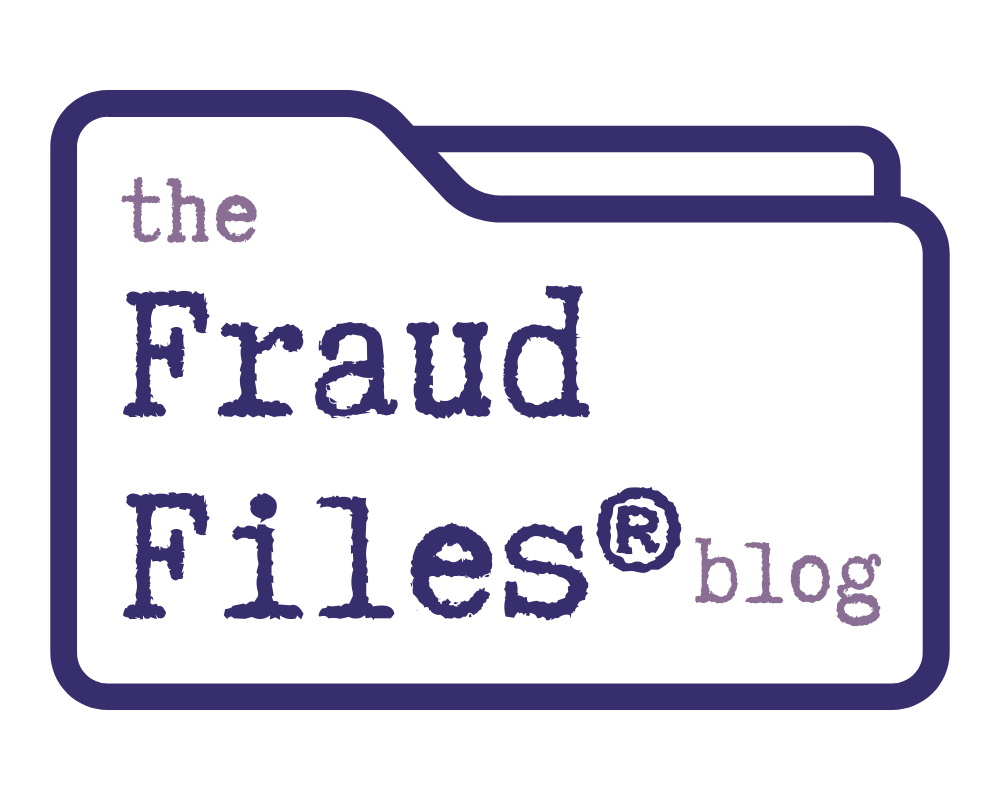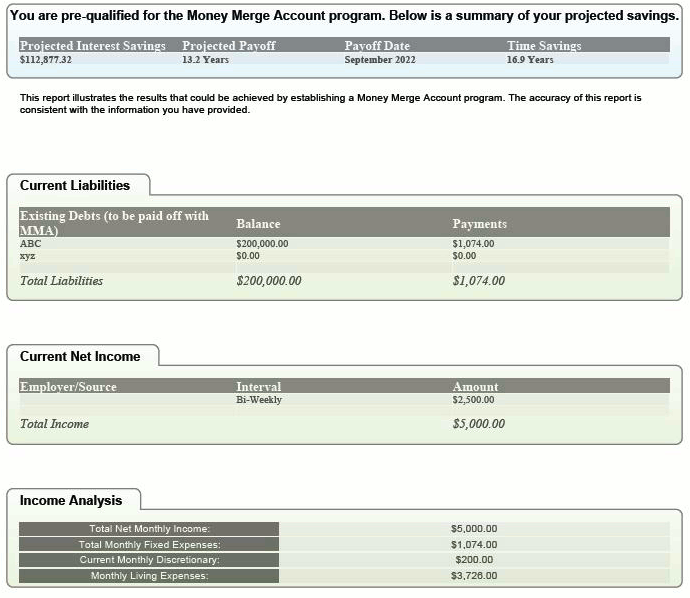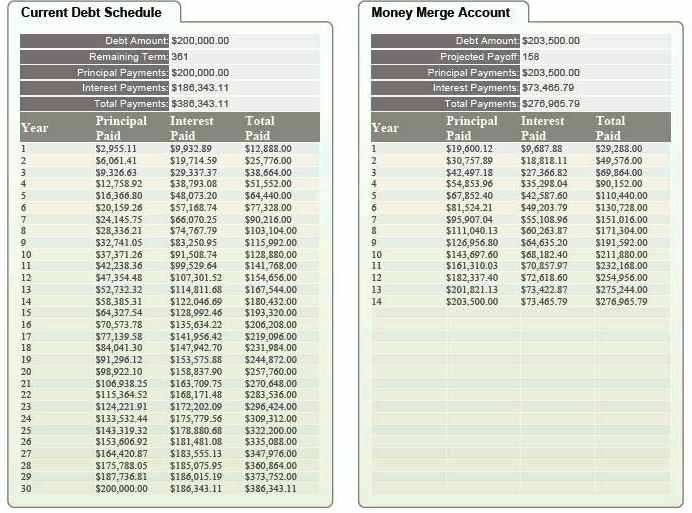Today a seller of the United First Financial Money Merge Account product threw out a challenge: Show him how a simple spreadsheet can pay off a mortgage faster than MMA. He said that his client owed $200,000 on a mortgage, and with only $200 “extra” cash left each month after regular living expenses, the MMA product made it possible to pay off that 30 year mortgage in only 13.2 years.
That MMA must be something special!!! No regular person could pay off a mortgage so fast with so little extra money.
I took the reader up on his challenge. I asked for the MMA analysis provided by the software, detailing this 13.2 year payoff. I said that with that data in hand, I’d beat the MMA payoff schedule. In all fairness, I knew when I asked for it that there was funny business involved. It’s not possible to pay off a $200,000 mortgage in less than half of the 30-year payoff schedule with only $200 extra each month applied to the mortgage.
And the data provided proves that UFF and their software is defrauding consumers. Here’s what was in that analysis (click on images to see them full-size):
It doesn’t take a trained investigator to spot the fraud in this analysis. In the first graphic, the printout shows $5,000 total monthly income. (That’s actually incorrect, based on the $2,500 bi-weekly income shown above that. The correct figure should be ($2,500 x 26) / 12 = $5,417 per month.)
The printout then shows below that $200 discretionary income each month… implying that the customer has only $200 extra each month to apply to the mortgage.
Except when you scroll down to the side-by-side analysis of before and after the MMA… you see that in year one there is a total paid of $12,888 without MMA, versus $29,288 paid with the MMA. That’s a difference of $16,400 extra paid under the MMA scenario, or almost $1,400 per month? Where did that money come from? The MMA certainly didn’t generate that cash or generate that savings!!!
The MMA seller told me this is where the $1,400 per month comes from. (Please don’t don’t hurt yourself when you fall over laughing.)
MMA does not simply add $200 a month to a client’s mortgage payment (surely only an idiot would pay $3,500 for that); it uses the HELOC’s simple open-interest (pay only for the amount you use) against the mortgage’s amortizing, closed-end interest (100% interest in the beginning; 100% principal at the end). A “5% mortgage” is only a true 5% on its last day because it is all interest for the first several years.
This has the effect of supercharging the $200 discretionary funds; essentially, the client is going to borrow money from the Heloc and make much larger payments to mortgage principal than they otherwise could and then pay off the Heloc draw the next month with employment income and discretionary income. The math algorithms within the software that make those calculations and suggestions are what clients pay for (and as I mentioned, the large amount of commissions paid out by the company for its MLM structure).
Merely a shred of common sense would tell someone that the MMA tool couldn’t magically multiply that $200 each month by seven to make a $1400 extra payment on the mortgage. But the trick MMA uses is to tell the consumer that this is all a result of a “complicated algorithm” that optimizes their money. If you don’t have facts on your side, I guess you’re left to dazzle people with fancy sounding (but false) words.
If you wonder how consumers get conned into wasting $3,500 on this stupid software, it’s easy to see…
- Turning $200 into $1400 each month sounds very enticing.
- Even the company’s own representatives don’t understand what they’re selling and can’t comprehend how wrong the analysis provided to customers is.
The truth is that the money shuffle U1st Financial has people do via the Money Merge Account saves the average consumer about $20 or $30 a month, at best. Any savings beyond that can only come from making extra payments on principal each month… and that money comes straight out of your pocket.
The analysis provided to the consumer by the MMA representative is fraudulent, plain and simple.
UPDATE: The UFF representative still contends that only $200 cash each month is put into the mortgage by the consumer, and that the use of the HELOC and complicated equations in the MMA software turn it into the $1400 per month shown on the side-by-side analysis.
11 Comments
Leave a Reply






What a joke. The same agent engaged me elsewhere, and where I said $200/mo extra will drop the mortgage to about 21 years, he insisted 13.2.
I challenged him to send the sheet, which I guess is on the way. Said I’d catch the error in seconds. But I don’t have a monopoly on 4th grade math. You caught the error as quickly as I’d have. You know, swapping bi-weekly for semi-monthly is the easiest error to make, and creates an extra 8% or so of gross income, which of course doesn’t exist. Yet agents are too …. to notice that large an error. How far from NY to LA? 3000 miles? Close enough, Tracy. A million miles? Close enough for agents of MMA.
(I appreciate the link here, as always)
Joe
OK, so if there is $200 monthly in stated discretionary income plus $417 monthly in the bi-weekly/semi-monthly error, that amounts to $617 per month that can be applied to the mortgage. $617 x 12 = $7,404 in the first year. They show an additional $16,400 paid. Where are they getting the other $8,996? Is there a balance on the HELOC at the end of year one? Otherwise, where are they getting the extra money?
It’s interesting that in every year after the first year, the amount paid that year toward the mortgage is exactly $7,400 (the consumer’s REAL discretionary income). So if this is the case, the consumer borrows $8,996 against his HELOC which he cannot ever pay off during the course of his mortgage. Thus, he should have a HELOC balance after 13 years of around $19,000. Given his mortgage payment of $1,074 and his use of discretionary funds ($617) he could then apply that $1,691 to the HELOC and have it paid off in a year or so, being completely out of debt in 14 years.
Which is LONGER than if the consumer had just applied his REAL discretionary income of $617 to his mortgage in the first place.
Hooray for 4th grade math! Boo for UFF/MMA.
Darnit TJ! Silly consumers aren’t supposed to be able to add and subtract. MMA is a VERRRRRRY COMPLICATED math problem and no one knows the true secret that lets it create money out of thin air!!!
Seriously… thank you for proving that consumers have common sense.
Well, last night I was sent the same analysis, and pointed out the semi-monthly vs bi-weekly error. He wrote back that his number was now a 20.8 year payoff. But, I’ll add – the PDF had shown that he assumed a combined checking and saving total of $6500, which of course accounts for that first year higher payment. On my simple spreadsheet, when I include that $6500, and adjust the interest rate to 5% as that’s what he used (my challenge said stick to the regular example, 6%, whatever), the payoff drops to 20yrs, 1 month vs MMA 20yrs 10 months. The difference of 9 months matches pretty well to the fact that $3500 would grow to $9287 at 5% over the 20yrs. (9287/1074 pmt = 8.65 months worth of payments difference)
Whenever an agent is honest about their results, and we don’t let then assume outrageously high extra money to throw at the program, it’s easy to sift out that the program itself is a cost, not an investment. As you and I have been saying, Tracy, the numbers don’t lie.
Nice work Joe! The analysis done by UFF is still deceitful – It doesn’t make it clear to the consumer that:
1. They have more than $200 “extra” each month.
2. They’re going to have to drain their checking and savings to do the program. (Duh, if you throw a bunch of cash at your mortgage it saves you money. But you can do that for free, without MMA.)
3. The $3500 cost of MMA doesn’t get the consumer ahead at all. In fact, the cost puts them behind because of the interest accumulating on it.
This “pay down your mortgage with no change in lifestyle” sounds wonderful… But if consumers realized how this really worked and didn’t believe the lies of people like this agent, there’s no way they’d spend the money.
It should be noted that the UFirst agent in this case has actually come forward on another blog, and now admits defeat of the MMA against a simpler DIY approach, and claims he will not offer the MMA in the future:
http://www.bargaineering.com/articles/united-first-financial-money-merge-accounts-scam-or-legit.html/comment-page-7#comment-317257
We really need a directory of all these agents, both the reasonable ones who admit the MMA is a bad product, and the the con artists who simply walk away from challenges once their MMA is proven to be inefficient, or they are proven to be liars.
Craig – the honest agent list is small. The innumerate list is nearly all of them. They believe the mistakes they see because that want to believe in the holy grail.
Funny, the poster NJBlue went to Tracy, while it was my challenge to him regarding the $200. I chose that number to make the error more obvious, and not argue about a much lower number.
I’ll ask Tracy to view and let this You Tube link through http://tinyurl.com/l36q5o
It’s a well scripted cute video which explains how for the early part of your mortgage say the first 15 years, the effective rate is 24%. Now, I’ll admit, I still need to figure out how in the world he calculates this. You realize, I can easily calculate the truth, but figuring out others’ errors is a bit tougher. The video got 252 views but only my comment trying to explain the error, as in 6% is 6% regardless of timing.
How much do you owe on the HELOC after you finish paying your mortgage? Other than the obviously fuzzy math, is this what they are not telling consumers? That they have merely moved their mortgage into a HELOC that then needs to be paid off?
I must admit that I too was one of those brainwashed U1st agents to even bought the plan over 2 years ago. My analysis showed that I would pay off my mortgage in 8.7 years instead of 26. Well, two years later, I still owe $222,000 down from $226,000. Somehow it’s hard to believe that I’m going to pay off $222,000 in another 6 years! ha.
I feel like I should go back and apologize to everyone that I sold a money merge account to. Take the advice from someone who sold their plan for 2.5 years. DON’T waste your money!
Marty,
Wow, that is a big difference. What was the reason for such a large discrepancy? Did the agent who sold it to you include future hypothetical MMA sales or something?
[…] Posted on December 21st, 2009 Anyone who has spent some time on this site knows I’m no fan of the United First Financial Money Merge Account (UFF MMA). This “revolutionary” software is supposed to help you pay off your mortgage in record time, all for the low, low price of $3,500. Unfortunately, it’s being marketed with lies, and the UFF proponents who comment here consistently repeat the lies. […]